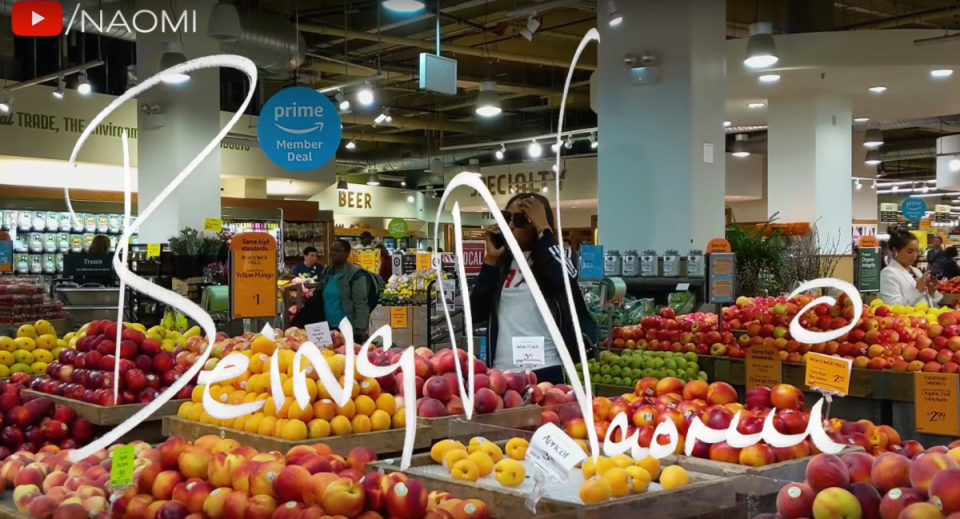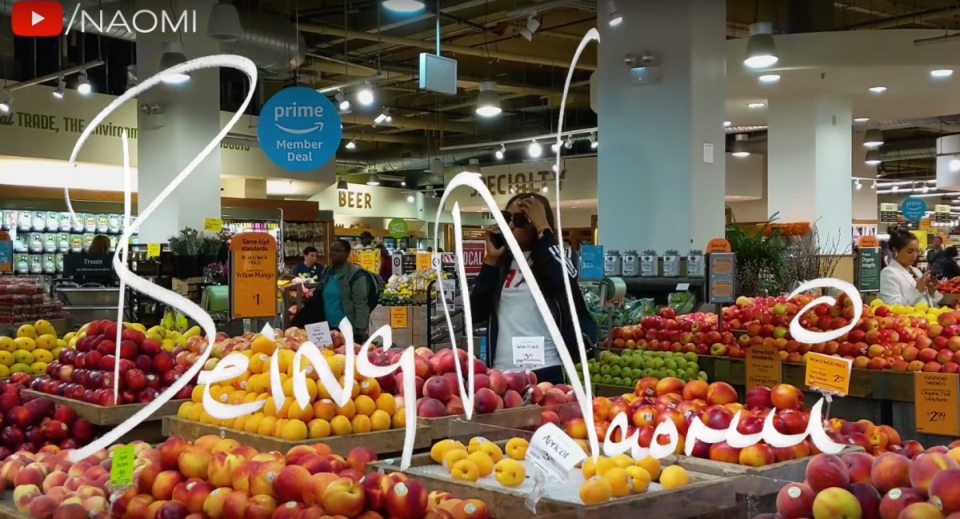Can Turning Fashion People Into YouTube Creators Translate to Cash?
Will clickbait-y videos of Naomi Campbell grocery shopping or Marc Jacobs learning to drive actually connect with large enough audiences to bring in ad dollars for brands?
On Monday evening, Marc Jacobs uploaded a video to his personal YouTube channel with the title, "Marc Jacobs Learns How To Drive and Goes Car Shopping." "Driving Miss Marc Jacobs," he pans dryly at the camera while wearing a look that can best be described as extra: an orange bucket hat, a pink The Marc Jacobs sweatsuit, Adidas slides with socks and rose-tinted sunglasses.
The 5-minute, 4-second clip is pretty mundane; Jacobs practices rules of the road in the parking lot of a Home Depot, cracking occasional jokes and making witty banter. About halfway through, he ends up at a Greenwich, Connecticut, car dealership, trying on Porsches for size. This is when the audience finally gets a glimpse of the content they presumably tuned in for: Watching a larger-than-life fashion icon spend part of his fortune on a midlife crisis toy, a situation that, until very recently, the public would have never had access to view.
Arguably more so than that of Hollywood celebrity, the fashion world and its major players are notoriously shrouded in exclusivity and glamour. The lives of editors, supermodels and designers are equated with expensive clothes, frequent trips to Milan and Paris, tight guest lists and general excess. Though it's a well-known fact that the industry is struggling in many areas — publishing, retail and talent retention, for starters — its reputation of high aspiration has remained. While bloggers and influencers were initially lauded for helping the industry seem more accessible, the most successful of them are now famous in their own right and have spawned an entire economy that has marketing and advertising budgets increasingly flowing to Instagram — and now YouTube.
Derek Blasberg was hired as YouTube's head of fashion and beauty partnerships — the platform's answer to Instagram's Eva Chen — last June, and since then, he's convinced the likes of Victoria Beckham, Naomi Campbell, Alexa Chung, Rosie Huntington-Whiteley and Jacobs to start vlogging on a regular basis in pursuit of views, likes and channel subscribers. Additionally, he masterminded some very clever partnerships with popular creators: Emma Chamberlain and the Dolan Twins, whose channels have more than 8M and 10M subscribers, respectively, sat front row at Louis Vuitton's runway shows for the past couple of seasons. YouTube personalities Rickey Thompson and Jay Versace have hosted videos and livestreams for Alexander Wang, too; Liza Koshy, a YouTuber with a whopping 17M subscribers, hosted the 2019 Met Gala live stream for Vogue, wearing a couture look by Balmain and beauty vlogger James Charles attended the event, dressed by Wang.
Since taking on the role, every publication from WWD to Business of Fashion to Vogue Business has reported on Blasberg's strategies and whether YouTube can start attracting the same revenue numbers as Instagram, which reportedly brought in $9 billion in 2018. According to Vogue Business, a key part of Blasberg's plan has been to persuade fashion people to think and behave in a way that mimics the platform's top creators: By posting short, semi-candid videos that offer viewers unprecedented access into their personal lives, behind-the-scenes looks at the inner workings of the industry and share firsthand aspirational experiences (like going to a fashion show in Paris), all while coming off as authentic as possible.
The 56-year-old Jacobs, who is nothing short of an industry legend, has embraced social media as an unfiltered outlet for his delightfully humorous, borderline absurd personality. Most notably, he proposed to his now-husband Char Defrancesco with a flash mob inside of a Chipotle last April, which immediately and obviously went viral on Instagram. He is not shy about meme-ifying himself, either, often posting fit pics in sequins, sunglasses and babushkas, showing off his intricate nail art, practicing goat yoga with Real Housewife Lisa Rinna and, the ultimate Cool Teen move, vaping. (To be clear, vaping, not Juuling.)
About 12 hours after posting, Jacobs's driving clip had only racked up about 1,600 views. However, this video format should seem familiar to regular YouTube watchers, as it's a bit that popular creators have seen success with in the past. Take Tana Mongeau, for instance: The 21-year-old YouTuber with 4.7M subscribers posted a series of "learning to drive" videos in June in collaboration with both Jake Paul (19M subscribers) and David Dobrik (13M subscribers). The videos had typically clickbait-y titles — "JAKE PAUL TEACHES ME HOW TO DRIVE (in his $250,000 car)" — and currently have a combined view count of 8.5M. Besides Jacobs's celebrity status, there's not a whole lot going for this clip to make it enticing to watch over the millions of other videos published on the same day.
Of course, the Gen Z audience that fashion is trying to capture on YouTube has built relationships with these young, tireless creators who often post multiple videos per week, have spawned an entire ecosystem of niche drama and sell their own merch, often via limited-edition drops. Aside from teens who dream of working in fashion, how large is the audience actively seeking out content by designers or industry types who are not only much older than the Gen Z target, but whose lives are anything but relatable to their own?
This question has been at the top of my mind for a while, but it's Campbell's recent duo of viral videos that began to convince me the audience is there — and it's growing. Last week, the infamous supermodel posted a 5-minute, 19-second vlog entitled, "Naomi Campbell's Airport Routine | Come Fly With Me." While the subject matter wasn't exactly compelling — Campbell was doing little more than browsing a duty-free shop and boarding an airplane — her unapologetic authenticity was a magical thing to behold. Not only did the woman known for not getting out of bed for less than $10K a day put on a pair of rubber gloves and scrub her entire seat clean, she showcased her objectively neurotic in-air skin-care routine, consisting of enough products to fill an extra-large Ziploc bag. Plus, her soundbites were second to none. If you haven't watched, I insist that you change that right now.
Campbell's plane video has currently garnered more than 1.1M views, an impressive figure in such a short time. As a follow-up seven days later, she posted yet another seemingly dull activity to her channel: "Whole Foods Shopping With Naomi Campbell." Aside from the fact that, shocker, Campbell does her own grocery shopping, the dialogue gives an unprecedented peek at her personality, effectively humanizing her in a way that editorial imagery, PR-controlled media interviews, Instagram posts or public appearances never could. Sitting at just under 1M views, the comments section is brimming with fans lauding her humor, calling her "iconic" and asking for more videos on specific topics. While her page only has 268K subscribers currently, this type of engagement suggests that number could skyrocket if she continues posting with frequency and keeps her channel as unfiltered as possible.
Aside from Campbell's viral hits, subscriber and view counts on many fashion channels thus far are sleepy. (Beckham, for instance, has 102K subscribers, Chung has 116K and Jacobs is sitting at a mere 34K.) These numbers pale in comparison to the creators that Blasberg suggests they emulate, but the fashion channels not only publish less frequently than the Gen Z favorites, their content is also difficult to find, as YouTube doesn't have a dedicated hub that groups fashion channels together for quick browsing. They're also much less likely to hit the all-important "Trending" page, where you'll often find popular beauty tutorials, polished videos by publishers like Condé Nast or Complex and vlogs by the aforementioned Dolan Twins or Chamberlain.
Chamberlain in particular has emerged as a fashion darling: Aside from a shopping feature on this very website, she's been shot for W, profiled for the New York Times Styles section and starred in a series of sponsored Louis Vuitton videos — a couple of which were alongside noted coder Karlie Kloss. The sorts of lo-fi videos Chamberlain posts weekly are the antithesis of the Photoshop-heavy, highly produced and posed imagery that fashion brands swear by on Instagram, and that is frankly growing tiresome among youngsters starved for content they can relate to.
Her topics include everyday tasks like closet organization, shopping trips, DIY-ing outfits and getting dressed for a night out on the town in Los Angeles, made to sound at least vaguely exciting through their clever titles ("CLEANING OUT MY CLOSET *EXTREME*", "GET READY WITH ME TO GO OUT *TRANSFORMATION*" and "SELF IMPROVEMENT *i need help*"). At 18 years old, she not only appeals to fellow teens, she's also sought after by both accessible brands like Hollister and luxury houses like Louis Vuitton; while Gen Z is easily able to afford the former now, they'll theoretically spend their disposable income at the latter down the line.
And so the question remains: Can turning fashion icons into glorified YouTube creators really translate into views, subscriptions and ad revenue, or will Gen Z audiences write these channels off as little more than try-hard branded content? The way I see it, much of the breakdown will depend on perceived authenticity. Few industry types have the watchability or quotability of Campbell, so daily vlogs likely won't hit big numbers. However, if they play to their personal strengths, a natural audience will come.
For example, while I'm not super inclined to watch Jacobs learn how to drive, I am interested in watching him get his nails done, dress up for a drag ball or custom design a celebrity red carpet look. I'd love to come along as Chung went vintage shopping in her neighborhood or cleaned out her closet à la Chamberlain; I would easily tune in to see how Beckham packs for a vacation with her entire family, perhaps with some help from 8-year-old Harper.
But even if fashion-focused channels don't draw huge numbers in themselves, the industry has endless opportunity to partner with OG creators in innovative, organic ways. Louis Vuitton and Chamberlain/the Dolan Twins is an excellent example. Earlier this summer, vlogger and DJ Chantel Jeffries partnered with Revolve sub-brand Superdown on a capsule collection released via a shoppable music video that's garnered 4.7M views thus far. Plus, luxury resale site The RealReal has heavily invested in sponsoring YouTube videos for popular creators like Jeffries, Alissa Violet and Corinna Kopf. With their young fans eager to dress and shop just like them, announcing within the first few seconds of their vlogs where their outfits were sourced is invaluable marketing, especially as the resale market continues to boom.
"YouTube doesn't separate Naomi Campbell from Emma Chamberlain," Blasberg told Vogue Business. "These are both authoritative voices in fashion. Ultimately, when you're on YouTube, we want people to stay on YouTube." So perhaps the key to fashion's success on the platform isn't handing every industry icon a camera and seeing what sticks — rather, it's finding the best vehicle to give your customer something real (a factor that's seriously lacking in editorial and on Instagram) and relying less on viral trends or name-brand star power. Not everyone in fashion can carry an entertaining bit on video, but that doesn't mean there's not someone else on YouTube who can — and successfully sell goods on their behalf.
Sign up for our daily newsletter and get the latest industry news in your inbox every day.


